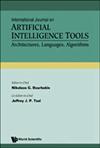基于混合锚定粒子群优化的尺度共轭梯度多层感知器视觉诱发电位脑电分类
IF 1
4区 计算机科学
Q4 COMPUTER SCIENCE, ARTIFICIAL INTELLIGENCE
International Journal on Artificial Intelligence Tools
Pub Date : 2023-05-01
DOI:10.1142/s021821302340016x
引用次数: 0
摘要
脑机接口是一个新兴的研究领域,其重点是将大脑数据转换为机器命令。由于脑电图的无创性,基于脑电图的脑机接口被广泛应用。脑电信号的分类是脑机接口应用的重要组成部分之一。稳态视觉诱发电位(SSVEP)范式与P300范式和运动意象范式相比,训练时间短,精度高,信息传递率高,因此具有重要的意义。为了提高SSVEP 6.66、7.5、8.57、10和12 Hz五类信号的分类精度,提出了一种基于混合锚定的粒子群优化缩放共轭梯度多层感知器分类器(APS-MLP)。缩放共轭梯度下降锚定粒子群优化的初始位置。每个粒子的最佳位置Pbest初始化一个SCG-MLP,通过平均每个SCG-MLP的精度获得APS-MLP的精度。将该方法与k-NN、SVM、LDA和MLP等标准分类器进行了比较。其中,本文算法的训练准确率和测试准确率分别达到了88.69%和95.4%,比基于脑电图的标准脑机接口分类器提高了12-15%。该算法具有鲁棒性,科恩kappa系数为0.96,将用于运动控制和改善残疾人生活质量等应用。本文章由计算机程序翻译,如有差异,请以英文原文为准。
Classification of Visually Evoked Potential EEG Using Hybrid Anchoring-based Particle Swarm Optimized Scaled Conjugate Gradient Multi-Layer Perceptron Classifier
Brain-Computer Interface is an emerging field that focuses on transforming brain data into machine commands. EEG-based BCI is widely used due to the non-invasive nature of Electroencephalogram. Classification of EEG signals is one of the primary components in BCI applications. Steady-State Visually Evoked Potential (SSVEP) paradigms have gained importance because of lesser training time, higher precision, and improved information transfer rate compared to P300 and motor imagery paradigms. In this paper, a novel hybrid Anchoring-based Particle Swarm Optimized Scaled Conjugate Gradient Multi-Layer Perceptron classifier (APS-MLP) is proposed to improve the classification accuracy of SSVEP five classes viz. 6.66, 7.5, 8.57, 10 and 12 Hz, signals. Scaled Conjugate Gradient descent anchors the initial position of Particle Swarm Optimization. The best position, Pbest, of each particle initializes an SCG-MLP, the accuracy of APS-MLP is obtained by averaging the accuracies of each SCG-MLP. The proposed method is compared with standard classifiers namely, k-NN, SVM, LDA and MLP. In which, the proposed algorithm achieves improved training and testing accuracies of 88.69% and 95.4% respectively, which is 12–15% higher than the standard EEG-based BCI classifiers. The proposed algorithm is robust, with a Cohen’s kappa coefficient of 0.96, and will be used in applications such as motion control and improving the quality of life for people with disabilities.
求助全文
通过发布文献求助,成功后即可免费获取论文全文。
去求助
来源期刊

International Journal on Artificial Intelligence Tools
工程技术-计算机:跨学科应用
CiteScore
2.10
自引率
9.10%
发文量
66
审稿时长
8.5 months
期刊介绍:
The International Journal on Artificial Intelligence Tools (IJAIT) provides an interdisciplinary forum in which AI scientists and professionals can share their research results and report new advances on AI tools or tools that use AI. Tools refer to architectures, languages or algorithms, which constitute the means connecting theory with applications. So, IJAIT is a medium for promoting general and/or special purpose tools, which are very important for the evolution of science and manipulation of knowledge. IJAIT can also be used as a test ground for new AI tools.
Topics covered by IJAIT include but are not limited to: AI in Bioinformatics, AI for Service Engineering, AI for Software Engineering, AI for Ubiquitous Computing, AI for Web Intelligence Applications, AI Parallel Processing Tools (hardware/software), AI Programming Languages, AI Tools for CAD and VLSI Analysis/Design/Testing, AI Tools for Computer Vision and Speech Understanding, AI Tools for Multimedia, Cognitive Informatics, Data Mining and Machine Learning Tools, Heuristic and AI Planning Strategies and Tools, Image Understanding, Integrated/Hybrid AI Approaches, Intelligent System Architectures, Knowledge-Based/Expert Systems, Knowledge Management and Processing Tools, Knowledge Representation Languages, Natural Language Understanding, Neural Networks for AI, Object-Oriented Programming for AI, Reasoning and Evolution of Knowledge Bases, Self-Healing and Autonomous Systems, and Software Engineering for AI.
 求助内容:
求助内容: 应助结果提醒方式:
应助结果提醒方式:


